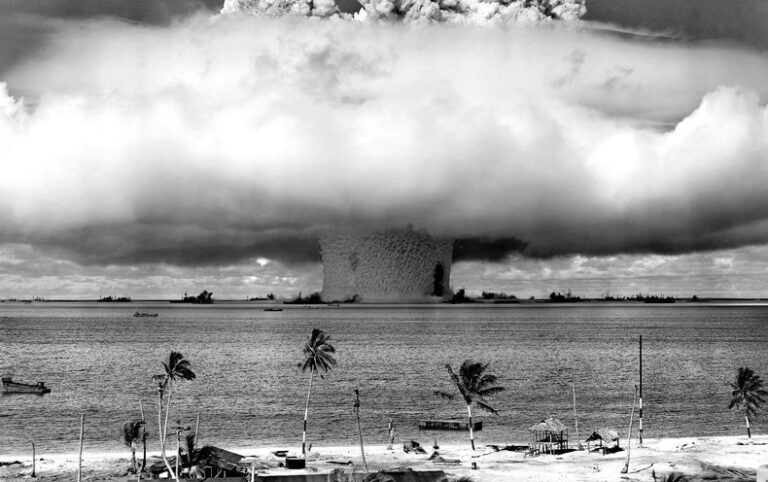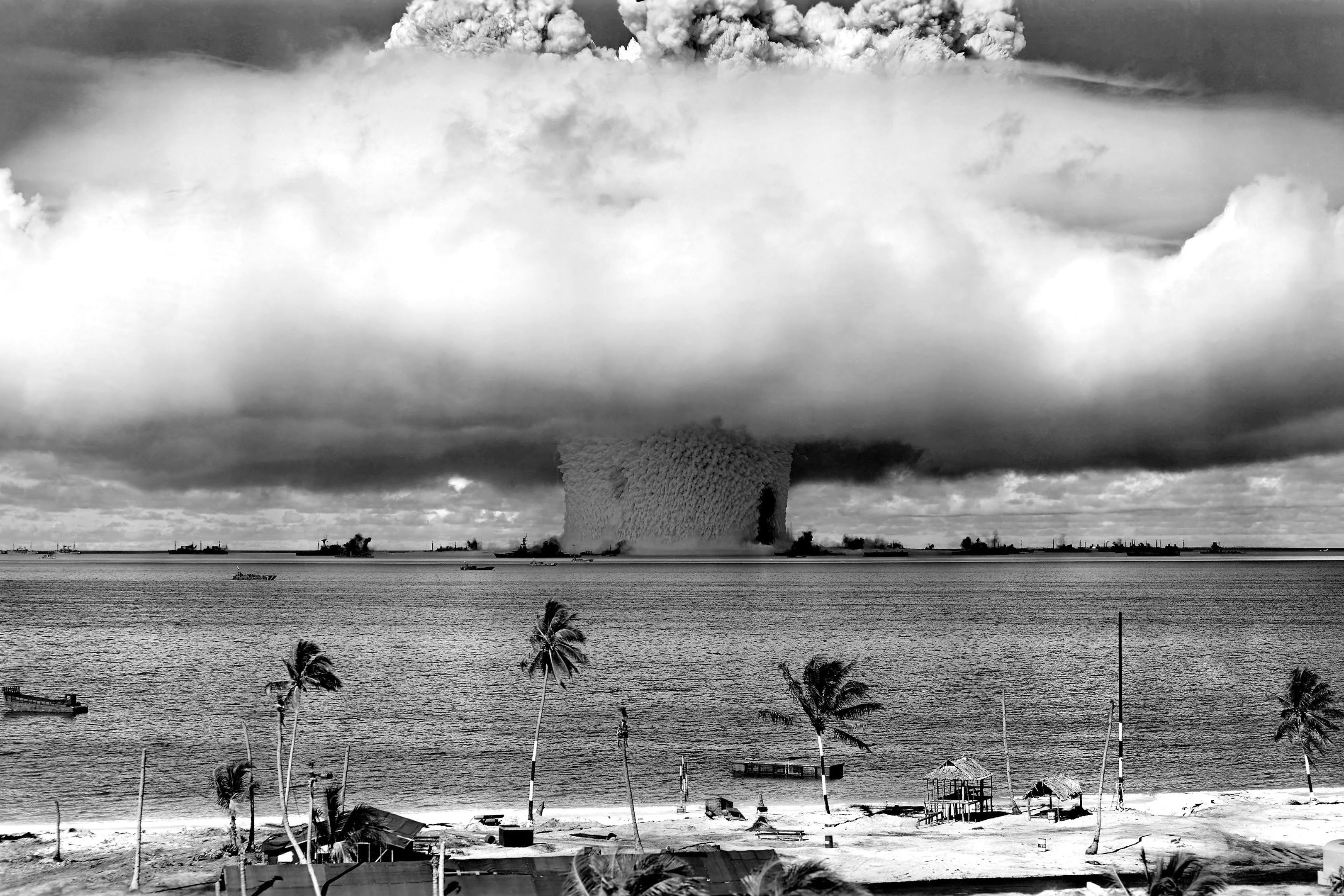
[ad_1]

The problem with nonfiction movies such as Oppenheimer is that real life usually doesn’t work in nice, clean storylines. Heroes and villains seldom battle it out in a convenient three-act structure. The narrative doesn’t typically come to a nail-biting climax followed by a satisfying ending that wraps up all the loose ends. Real life is mostly made up of loose ends, murky motivations, shades of gray and stories that move in fits and starts and peter out without a satisfying resolution.
Creative license comes in to help: a nonfiction moviemaker might smooth out the rough edges of the truth, just a touch, to make the story flow a little better or to make it just a wee bit easier to understand.
But science stubbornly resists smoothing; its facts simply don’t bend to narrative demands. And that’s what makes a film such as Oppenheimer so hard to pull off: it’s unbelievably difficult to tell a cracking story, one with all the tension and drama that the audience demands, while simultaneously staying true to the underlying science, characters and history. Almost always, it’s the science that gives first, sacrificed on the altar of story. On this front, Oppenheimer is no different.
There’s a lot of science underneath the Oppenheimer story, which makes it treacherous for a movie director. After all, J. Robert Oppenheimer was a physicist. You can’t understand him without understanding his science. Nor can you fully grasp his role in the Manhattan project, the most important scientific and engineering project of modern times. In some ways, the film’s writer and director Christopher Nolan goes to extremes to be true to scientific fact, even when it’s potentially damaging to the narrative. In one small but telling example, there’s the awkward fact that sound and light don’t travel at the same speed—awkward because the base camp, where Oppenheimer observed the detonation of the first atomic bomb, was about 10 miles from ground zero. That means a delay of roughly a minute—a full minute of awed silence before the blast in the movie’s soundtrack can catch up with the mushroom of fire obscenely unfolding itself on the screen. A lesser director would be terrified of that gap (if they were even aware of it), imagining the audience members squirming in their seats, waiting for the boom. Nolan not only is unafraid of showing the delay but (by my rough count in the movie theater) extends it by a good bit for dramatic emphasis—and even deploys the bright light/awkward extended silence/delayed bang as a leitmotif that reoccurs, to great effect, several other times in the film.
Oppenheimer shines when it comes to little scientific and engineering details such as this. The destructive gadget looks great, down to the shape of the explosive lenses that surrounded its core. Though I think I spotted a few anachronistic nixie tubes, glowing displays that were invented a decade later, overall, the film successfully gives a feeling of what Los Alamos Laboratory (now Los Alamos National Laboratory) and other 1940s labs were like.
The film is lighter on the science done in those labs. There’s a bit of talk about uranium and plutonium and of fusion and fission. Most of the science is correct. Apart from a bad description of the collapse of a black hole as a vicious cycle of increasing gravity and density—rather than as an object for which gravity no longer has any internal force capable of resisting its pull—the scientific explanations are decent, or at least defensible. But the science is minimal and appears mostly in passing—with no hint of process—and is only mentioned when necessary for a future plot point. For example, there’s not even an allusion to the problems with plutonium-240 contamination that caused a minor crisis in 1944 and a change in scientific direction. But even when the science can’t be avoided, it is not always set up adequately. Much of Oppenheimer’s life after Los Alamos had to do with the question of whether to develop the hydrogen bomb. There is simply not enough setup to explain the distinction between the atomic fission weapons developed during the Manhattan Project and the thermonuclear fusion weapons advocated by physicist Edward Teller and then Atomic Energy Commission member Lewis Strauss after the war ended. The film doesn’t make clear at all why they’re different scientifically, technically or morally. (Almost all the supporting scientists are reduced to their barest form, with the most extreme example being theoretical physicist Richard Feynman—who is essentially turned into a pair of bongo drums strategically deployed in a few key scenes.) As a result, the movie’s third act, coming after the natural climax of the Trinity test at Los Alamos, is largely unmoored from the scientifically motivated forces that paved the road to Oppenheimer’s downfall and caused a schism in the weapons physics community.
But there’s a deeper sacrifice of science to the altar of narrative in Oppenheimer, one that goes beyond mere avoidance. “You see beyond the world we live in,” a humanities professor tells Oppenheimer during the film. “There’s a price to be paid for that.” This sacrifice is not really like that of Prometheus, who gave the world fire and endured endless torture in payment, even though the mythological character is amply alluded to in the movie—and in the book it was based on, American Prometheus, by Martin Sherwin and Kai Bird. Instead the movie goes with another reason for Oppenheimer to pay: his punishment is not for bringing fire to humankind but for being an Icarus flying too close to the sun of science. It’s a simpler story than Prometheus’s and just as ancient. And now it’s a tired old trope, endlessly repeated (like an eagle tearing my liver) in movies about scientists, particularly physicists, and mathematicians: that they give up a piece of themselves—their relationships, their sanity, even their humanity—for their transcendent understanding. “I was tortured by visions of a hidden universe,” Oppenheimer tells the audience, as stars and abstract flashes of light representing the quantum realm flit across the screen, moments before, as a young man, he briefly functionally loses his sanity. The scientist who sees more than other mortals must be debilitated in some other way to compensate. The ancient Greeks imagined that Thales fell into a pit because he obsessively gazed upward at the stars. Nolan’s Oppenheimer is similarly stunted: “How could this man, who saw so much, be so blind?” muses one of the movie’s characters. Just so, Nolan sacrifices the hope of truly helping the audience understand a scientist as a person by instead making him otherworldly.
Like other science historians, I’ve got a lot of mixed emotions about Oppenheimer. It’s an artistic telling of the scientist’s story, and it’s far, far better than any other attempt so far. But without a real embrace of what it’s like to see the world through the lens of science, any attempt to tell Oppenheimer’s story, no matter how many hours of film reel the studio is willing to let the director release, will feel weirdly incomplete.
This is an opinion and analysis article, and the views expressed by the author or authors are not necessarily those of Scientific American.
[ad_2]